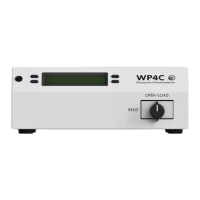18
SYSTEM
3.3.2.1. TEMPERATURE EFFECTS
Temperature plays a critical role in water potential determinations. Most critical is
the measurement of the difference between sample and dew point temperature. For
water potential measurements to be accurate to 0.05 MPa, temperature difference
measurements need to be accurate to 0.006 °C.
The WP4C IR thermometer measures the difference in temperature between the sample
surface and the sample block. The thermometer is carefully calibrated to minimize
temperature errors; however, achieving 0.006 °C accuracy is difficult when temperature
differences are large. Most accurate measurements are obtained when the sample is near
block temperature.
Another effect of temperature on water potential occurs with samples that are near
saturation (like many soil samples). A sample that is close to 0.00 MPa and is only slightly
warmer than the sensor block will condense water within the block. This will cause errors
in the measurement and in subsequent measurements until the condensation disappears.
There is a linear relationship between the sample dew point temperature and its water
potential. The dew point decreases −0.12 °C/MPa. For example, a very dry sample at
−40 MPa can be 4.8 °C (−.12 × −40) above the block temperature without condensing. A
sample at −1 MPa (fairly dry for most soils) can be 0.12 °C above the block temperature
without condensing. Therefore, if the general range of the sample water potential is known,
the temperature it will condense moisture can be determined. Monitor the temperature
difference between the sample and the block using the Sample Temperature screen to
ensure the sample will not condense on the sensor block (Section3.2.4.4).
3.3.2.2. OSMOTIC EFFECTS
The WP4C measures the sum of osmotic and matric potential. An approximate value for
the osmotic potential can be found by measuring the electrical conductivity (EC) of the
saturation extract of the soil. The osmotic potential of the saturation extract is computed
using Equation 2:
Equation 2
Ψ=−
The osmotic component of the water potential is then computed using Equation 3:
Equation 3
θ
θ
Ψ=Ψ
os
s
where θ is the volumetric water content of the sample and θ
s
is the volumetric water
content at saturation. The matric potential is the total potential minus the osmotic.

